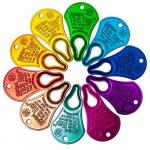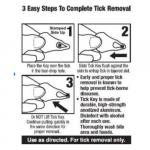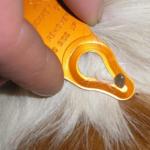Tick: Removal, The Tick Key, Portable Lightweight Tool
Fabricated From High-Strength Anodized Aluminum
Easily Stored In A Wallet, Pocket, or on A Key Chain, Collar, Or A Leash
Uses natural forward leverage to remove the entire tick; head and all, quickly and safely.
99.9% effective on the removal of all sizes and types of ticks, on both people and pet; This flat tool is easy to store or carry.
TELL US YOUR FAVOURITE 2 OR 3 COLOUR CHOICES. We'll do our best.
FOLLOW YOUR LOCAL HEALTH AUTHORITY'S ADVICE.
How do I remove a tick?
Your main aims are to remove the tick promptly, to remove all parts of the tick's body and to prevent it from releasing additional saliva or regurgitating its stomach contents into your bite wound.
DO start by cleansing the tweezers/tool with antiseptic. After tick removal, cleanse the bite site and the tool with antiseptic.
DO wash hands thoroughly afterwards.
DO save the tick in a container in case a doctor asks for evidence that you have been bitten and so that the tick can be tested for infections (label it with date and location).
DO NOT squeeze the body of the tick, as this may cause the head and body to separate, leaving the head embedded in your skin.
DO NOT use your fingernails to remove a tick. Infection can enter via any breaks in your skin, e.g. close to the fingernail.
DO NOT crush the tick's body, as this may cause it to regurgitate its infected stomach contents into the bite wound.
DO NOT try to burn the tick off, apply petroleum jelly, nail polish or any other chemical. Any of these methods can cause discomfort to the tick, resulting in regurgitation, or saliva release.
Disposing of the tick
Be aware that engorged ticks will contain potentially infected blood, which may splatter when crushed. Do not crush the tick with your fingers and do not allow the crushed tick or the blood it carried to contact your skin.





